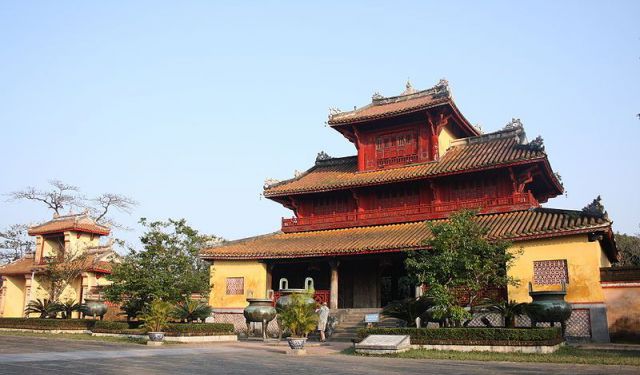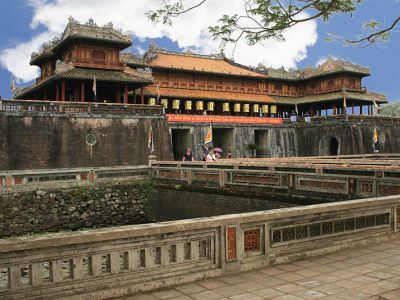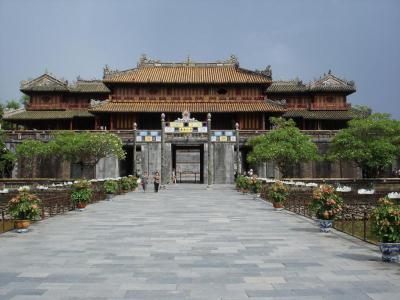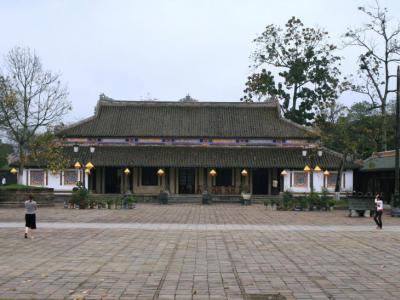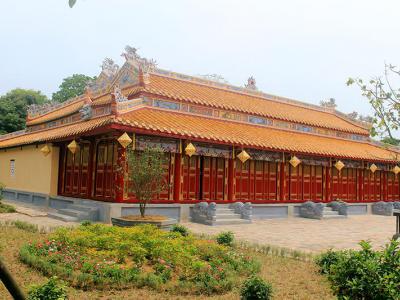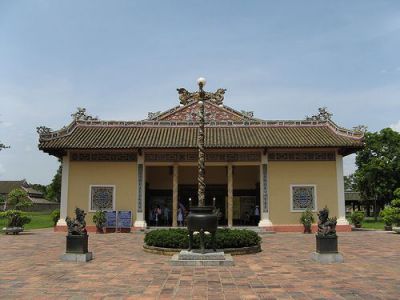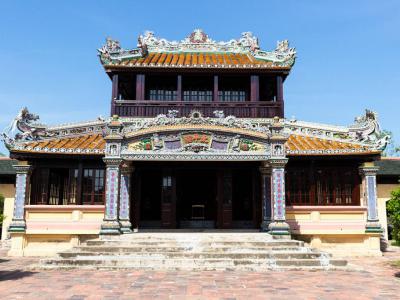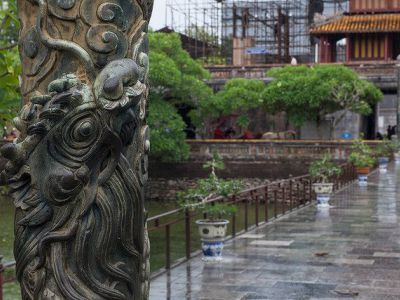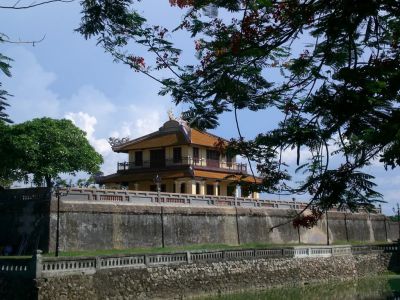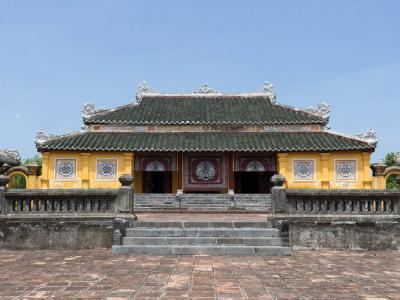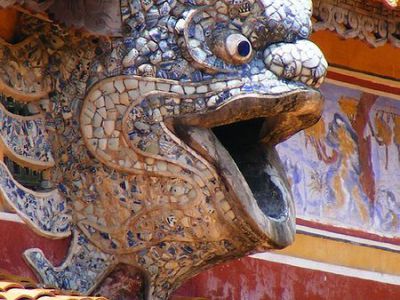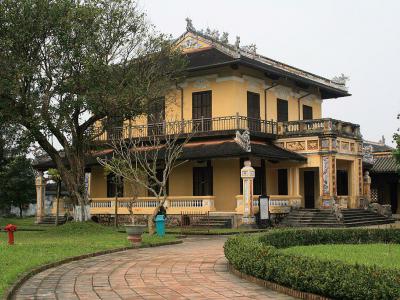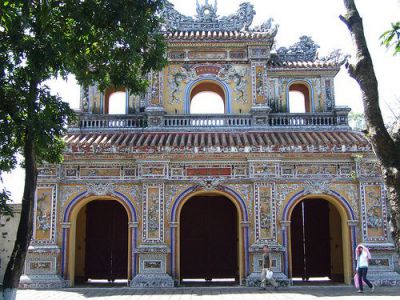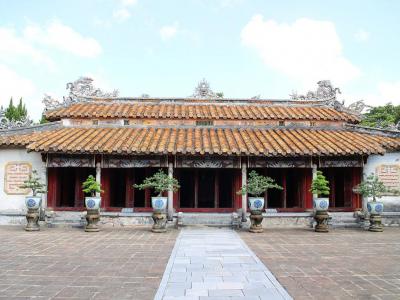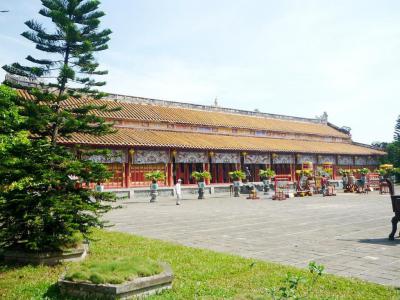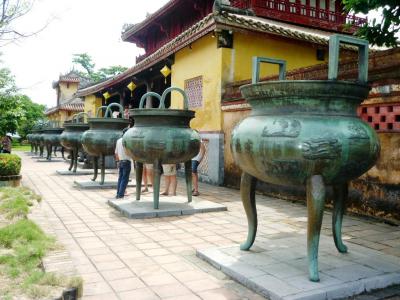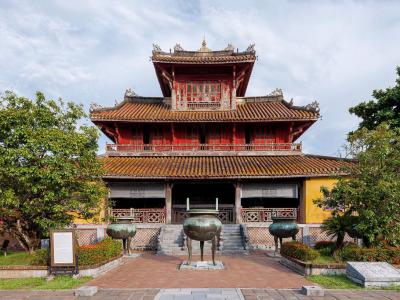Imperial City Walking Tour (Self Guided), Hue
The Kings of the Nguyen Dynasty built their feudal capital along the fertile banks of the Perfume River, whose steady flow, centuries on, still sets up a languid pace that the rest of the city is happy to follow.
Situated within the walls of the Royal Citadel, The Imperial City in Hue is one of, if not the most prominent landmark in Vietnam, renowned for its wonderful collection of oriental architecture. Constructed in 1803 under Emperor Gia Long, it served mostly ceremonial function during the French colonial period.
After the end of the monarchy in 1945, the complex suffered heavy damage during the Indochina and then Vietnam wars and was largely neglected throughout the 1980s. Many of the former royal buildings, museums, libraries, and Buddhist shrines, including the Temple of Heaven, were subsequently rebuilt, and in 1993 earned Hue the title of a UNESCO World Heritage Site.
The Site mainly comprises the Citadel, complete with the Imperial City and the Forbidden Purple City (once the emperor's home) separated by seven barriers, plus some other related buildings in the immediate vicinity. At the entrance to the Citadel is the Ngo Môn gate, where the emperor announced his decisions; the Palace of Supreme Harmony, throne room with purple and yellow lacquered columns; and the Imperial Museum which houses royal clothing, furniture and porcelain. The Forbidden Purple City also includes the Royal Theater where traditional Vietnamese performances are still given today.
To get acquainted with the legacy of Vietnam’s last royal family and explore the surviving evidence of their 143-year long reign, follow this self-guided walking tour.
Situated within the walls of the Royal Citadel, The Imperial City in Hue is one of, if not the most prominent landmark in Vietnam, renowned for its wonderful collection of oriental architecture. Constructed in 1803 under Emperor Gia Long, it served mostly ceremonial function during the French colonial period.
After the end of the monarchy in 1945, the complex suffered heavy damage during the Indochina and then Vietnam wars and was largely neglected throughout the 1980s. Many of the former royal buildings, museums, libraries, and Buddhist shrines, including the Temple of Heaven, were subsequently rebuilt, and in 1993 earned Hue the title of a UNESCO World Heritage Site.
The Site mainly comprises the Citadel, complete with the Imperial City and the Forbidden Purple City (once the emperor's home) separated by seven barriers, plus some other related buildings in the immediate vicinity. At the entrance to the Citadel is the Ngo Môn gate, where the emperor announced his decisions; the Palace of Supreme Harmony, throne room with purple and yellow lacquered columns; and the Imperial Museum which houses royal clothing, furniture and porcelain. The Forbidden Purple City also includes the Royal Theater where traditional Vietnamese performances are still given today.
To get acquainted with the legacy of Vietnam’s last royal family and explore the surviving evidence of their 143-year long reign, follow this self-guided walking tour.
How it works: Download the app "GPSmyCity: Walks in 1K+ Cities" from Apple App Store or Google Play Store to your mobile phone or tablet. The app turns your mobile device into a personal tour guide and its built-in GPS navigation functions guide you from one tour stop to next. The app works offline, so no data plan is needed when traveling abroad.
Imperial City Walking Tour Map
Guide Name: Imperial City Walking Tour
Guide Location: Vietnam » Hue (See other walking tours in Hue)
Guide Type: Self-guided Walking Tour (Sightseeing)
# of Attractions: 17
Tour Duration: 2 Hour(s)
Travel Distance: 2.9 Km or 1.8 Miles
Author: DanaOffice
Sight(s) Featured in This Guide:
Guide Location: Vietnam » Hue (See other walking tours in Hue)
Guide Type: Self-guided Walking Tour (Sightseeing)
# of Attractions: 17
Tour Duration: 2 Hour(s)
Travel Distance: 2.9 Km or 1.8 Miles
Author: DanaOffice
Sight(s) Featured in This Guide:
- Cửa Ngọ Môn (Meridian Gate)
- Forbidden Purple City
- Điện Thái Hoà (The Palace of Supreme Harmony)
- Tả Vu và Hữu Vu (Ta Vu and Huu Vu)
- Triệu Miếu (Trieu Temple)
- Duyệt Thị Đường (Royal Theater)
- Thái Bình Lâu (Royal Reading Pavilion)
- Cửa Hòa Bình (Peace Gate)
- Lầu Tứ Phương Vô Sự (Tu Phuong Vo Su Floor)
- Cung Trường Sanh (Grand Queen Mother’s Residence)
- Điện Thọ Ninh (Ninh Dien Tho)
- Cung Diên Thọ (Dien Tho Palace)
- Cửa Chương Đức (Chuong Duc Gate)
- Hưng Tổ Miếu (Temple of the Resurrection)
- Thế Tổ Miếu (Temple of the Generations)
- Cửu Đỉnh (The Nine Dynastic Urns)
- Hiển Lâm Các (Pavilion of the Glorious Coming)
1) Cửa Ngọ Môn (Meridian Gate)
Meridian Gate (Cua Ngo Mon) is the grand main entrance to the Imperial City of Hue and a defining symbol of Vietnam’s Nguyen dynasty heritage. Constructed in 1833 during the reign of Emperor Minh Mang, the gate served as both a ceremonial entryway and an architectural statement of imperial authority. Inspired by Chinese fortress design, it was carefully aligned with the “meridian line” of the citadel, reflecting the Confucian principles of order and symmetry that shaped royal planning.
The structure consists of a U-shaped base made of stone and brick, topped with the elegant two-story pavilion known as the Lau Ngu Phung (Five Phoenix Pavilion). This upper wooden structure-once reserved exclusively for the emperor and royal court-was used for important occasions, such as troop reviews, royal proclamations, or public ceremonies during festivals. Flanked by bastions and flaring eaves, the Meridian Gate strikes a balance between military might and aesthetic refinement, combining watchtower utility with graceful ornamentation.
In contrast to its commanding size and royal function, only the emperor could use the central passage; mandarins and officials entered through the side arches, reinforcing the rigid social hierarchy of the imperial system. Today, visitors can walk through the same gates once reserved for the elite, pausing to admire the gate’s symmetry, dragon carvings, and yellow-glazed roof tiles-symbols of imperial power.
A visit to the Meridian Gate offers more than an entry into the citadel-it provides a vivid introduction to the ceremonial grandeur and deeply structured society of Vietnam’s last imperial era.
The structure consists of a U-shaped base made of stone and brick, topped with the elegant two-story pavilion known as the Lau Ngu Phung (Five Phoenix Pavilion). This upper wooden structure-once reserved exclusively for the emperor and royal court-was used for important occasions, such as troop reviews, royal proclamations, or public ceremonies during festivals. Flanked by bastions and flaring eaves, the Meridian Gate strikes a balance between military might and aesthetic refinement, combining watchtower utility with graceful ornamentation.
In contrast to its commanding size and royal function, only the emperor could use the central passage; mandarins and officials entered through the side arches, reinforcing the rigid social hierarchy of the imperial system. Today, visitors can walk through the same gates once reserved for the elite, pausing to admire the gate’s symmetry, dragon carvings, and yellow-glazed roof tiles-symbols of imperial power.
A visit to the Meridian Gate offers more than an entry into the citadel-it provides a vivid introduction to the ceremonial grandeur and deeply structured society of Vietnam’s last imperial era.
2) Forbidden Purple City
The Forbidden Purple City (Tu Cam Thanh) lies at the heart of Hue’s Imperial Citadel and once served as the exclusive inner sanctum of Vietnam’s Nguyen emperors. Modeled after Beijing’s Forbidden City, this secluded compound was established in the early 19th century under Emperor Gia Long and expanded under his successors. Access was tightly controlled-only the emperor, his family, and a select group of mandarins and servants were allowed inside, earning it the moniker “purple,” a reference to the color associated with imperial authority.
Surrounded by brick walls and a protective moat, the Forbidden Purple City originally contained over 50 buildings, including royal residences, libraries, ceremonial halls, and private gardens. Much of its layout reflected Confucian ideals of harmony and order, with structures carefully positioned along a central axis. While many of these buildings were damaged or destroyed during wars and natural disasters, efforts have been ongoing to preserve and restore what remains.
Visitors today can wander the grounds and see surviving elements such as the Duyet Thi Duong royal theater, the Can Chanh Palace foundation, and a few ornamental gates and pavilions. Interpretive signage and quiet walkways offer a contemplative atmosphere amid the echoes of royal life that once thrived behind these walls. Though its grandeur has faded, the Forbidden Purple City still conveys the ceremonial weight and intimate rhythms of imperial life.
As part of the larger UNESCO-listed Complex of Hue Monuments, the site invites travelers to explore Vietnam’s dynastic past through a space both regal and deeply human in scale.
Surrounded by brick walls and a protective moat, the Forbidden Purple City originally contained over 50 buildings, including royal residences, libraries, ceremonial halls, and private gardens. Much of its layout reflected Confucian ideals of harmony and order, with structures carefully positioned along a central axis. While many of these buildings were damaged or destroyed during wars and natural disasters, efforts have been ongoing to preserve and restore what remains.
Visitors today can wander the grounds and see surviving elements such as the Duyet Thi Duong royal theater, the Can Chanh Palace foundation, and a few ornamental gates and pavilions. Interpretive signage and quiet walkways offer a contemplative atmosphere amid the echoes of royal life that once thrived behind these walls. Though its grandeur has faded, the Forbidden Purple City still conveys the ceremonial weight and intimate rhythms of imperial life.
As part of the larger UNESCO-listed Complex of Hue Monuments, the site invites travelers to explore Vietnam’s dynastic past through a space both regal and deeply human in scale.
3) Điện Thái Hoà (The Palace of Supreme Harmony)
Situated at the heart of Hue’s Imperial City, the Palace of Supreme Harmony (Dien Thai Hoa) stands as the most magnificent and symbolically charged structure of the Nguyen dynasty. Built between February and October 1805 under Emperor Gia Long, it was originally positioned further north before being relocated and expanded by Emperor Minh Mang in 1833. The palace commands its place immediately past the Noon Gate (Ngo Mon) and overlooks the vast ceremonial courtyard where the emperor received mandarins and foreign dignitaries.
The name "Thai Hoa" carries deep meaning: “Thai” signifies grandeur and greatness, while “Hoa” embodies harmony, together evoking the ideal of a prosperous, balanced dynasty. Architecturally, the palace features a notable double-roof structure resting on 80 lacquered ironwood columns adorned with intricate dragon-and-cloud motifs, emblematic of imperial authority. The throne hall’s elevated wooden platform, golden canopy, and glazed yellow roof tiles create a dazzling display of regal aesthetics.
Dien Thai Hoa hosted key state ceremonies: coronations, imperial birthdays, lunar-month meetings, and receptions for foreign envoys-13 feudal emperors from Gia Long to Bao Dai ascended their thrones here. Its acoustical design is so refined you can hear whispers across the hall-a testament to ancient Vietnamese ingenuity.
Although the palace has undergone several restorations since 1833 (notably in 1923 under Khai Dinh and ongoing through 2025), much of its grandeur and symbolic richness has been preserved. As a UNESCO-listed cultural treasure, the Palace of Supreme Harmony remains an essential stop for travelers seeking to grasp the majesty and legacy of Vietnam’s imperial past.
The name "Thai Hoa" carries deep meaning: “Thai” signifies grandeur and greatness, while “Hoa” embodies harmony, together evoking the ideal of a prosperous, balanced dynasty. Architecturally, the palace features a notable double-roof structure resting on 80 lacquered ironwood columns adorned with intricate dragon-and-cloud motifs, emblematic of imperial authority. The throne hall’s elevated wooden platform, golden canopy, and glazed yellow roof tiles create a dazzling display of regal aesthetics.
Dien Thai Hoa hosted key state ceremonies: coronations, imperial birthdays, lunar-month meetings, and receptions for foreign envoys-13 feudal emperors from Gia Long to Bao Dai ascended their thrones here. Its acoustical design is so refined you can hear whispers across the hall-a testament to ancient Vietnamese ingenuity.
Although the palace has undergone several restorations since 1833 (notably in 1923 under Khai Dinh and ongoing through 2025), much of its grandeur and symbolic richness has been preserved. As a UNESCO-listed cultural treasure, the Palace of Supreme Harmony remains an essential stop for travelers seeking to grasp the majesty and legacy of Vietnam’s imperial past.
4) Tả Vu và Hữu Vu (Ta Vu and Huu Vu)
Located within the Imperial City of Hue, Ta Vu and Huu Vu-meaning Left Hall and Right Hall-once served as vital administrative buildings during the Nguyen dynasty. Constructed in the early 19th century under Emperor Gia Long and completed during Minh Mang’s reign, these two symmetrical halls flank the courtyard in front of the Thai Hoa Palace, the former throne hall. Their placement and function reflected strict Confucian principles of order, hierarchy, and balance, which guided imperial governance.
Ta Vu was traditionally reserved for civil mandarins, while Huu Vu accommodated military officials. Each hall served as a meeting space where officials gathered before court sessions or participated in ceremonial events. The structures are nearly identical, featuring wooden pillars, tiled roofs, and raised platforms, with restrained architectural details in line with their administrative purpose. Their symmetrical design and proximity to the throne hall highlight their ceremonial significance and practical role in the inner workings of the royal court.
Though the halls were damaged during conflicts in the 20th century, both have been carefully restored to reflect their original appearance. Today, visitors can appreciate the architecture and layout while learning about the organization of imperial bureaucracy. Exhibits inside often include portraits of court officials, reproductions of royal decrees, and displays related to the Nguyen dynasty’s administrative system. Together, Ta Vu and Huu Vu offer a window into the structured, hierarchical world of Vietnam’s imperial past, where formality and function were meticulously integrated.
Ta Vu was traditionally reserved for civil mandarins, while Huu Vu accommodated military officials. Each hall served as a meeting space where officials gathered before court sessions or participated in ceremonial events. The structures are nearly identical, featuring wooden pillars, tiled roofs, and raised platforms, with restrained architectural details in line with their administrative purpose. Their symmetrical design and proximity to the throne hall highlight their ceremonial significance and practical role in the inner workings of the royal court.
Though the halls were damaged during conflicts in the 20th century, both have been carefully restored to reflect their original appearance. Today, visitors can appreciate the architecture and layout while learning about the organization of imperial bureaucracy. Exhibits inside often include portraits of court officials, reproductions of royal decrees, and displays related to the Nguyen dynasty’s administrative system. Together, Ta Vu and Huu Vu offer a window into the structured, hierarchical world of Vietnam’s imperial past, where formality and function were meticulously integrated.
5) Triệu Miếu (Trieu Temple)
Trieu Temple (Trieu Mieu) is one of the earliest and most historically significant ancestral temples in the Imperial City of Hue. Built in 1804 by Emperor Gia Long, it was dedicated to his grandfather, Nguyen Phuc Khoat, posthumously honored as Trieu To (the “Forefather Trieu”). The temple marked a key step in the Nguyen dynasty’s effort to establish dynastic legitimacy by linking their lineage to revered predecessors. Located near the southeastern section of the Citadel, Trieu Temple played a central role in royal ancestor worship and in affirming Confucian ideals of filial piety and continuity.
Architecturally, the temple reflects the restrained elegance of early Nguyen design. A wide courtyard leads to the main shrine, where red lacquered columns, intricately carved wooden beams, and yellow-glazed roof tiles create a dignified atmosphere of reverence. Stone steles, altars, and incense burners are positioned according to strict ceremonial hierarchy, while side structures once held ritual objects and offerings. Although more modest in scale than later temples such as The To Mieu, Trieu Temple’s symmetry and spatial order reflect the Confucian principles that guided court rituals.
Over time, the temple suffered damage during wartime and underwent periods of neglect. However, restoration efforts in the late 20th and early 21st centuries have helped preserve its original layout and design. Today, Trieu Temple offers visitors a quiet, contemplative glimpse into the spiritual and political life of Vietnam’s imperial court. Its historical significance and understated beauty make it a meaningful stop for those exploring Hue’s UNESCO-listed heritage.
Architecturally, the temple reflects the restrained elegance of early Nguyen design. A wide courtyard leads to the main shrine, where red lacquered columns, intricately carved wooden beams, and yellow-glazed roof tiles create a dignified atmosphere of reverence. Stone steles, altars, and incense burners are positioned according to strict ceremonial hierarchy, while side structures once held ritual objects and offerings. Although more modest in scale than later temples such as The To Mieu, Trieu Temple’s symmetry and spatial order reflect the Confucian principles that guided court rituals.
Over time, the temple suffered damage during wartime and underwent periods of neglect. However, restoration efforts in the late 20th and early 21st centuries have helped preserve its original layout and design. Today, Trieu Temple offers visitors a quiet, contemplative glimpse into the spiritual and political life of Vietnam’s imperial court. Its historical significance and understated beauty make it a meaningful stop for those exploring Hue’s UNESCO-listed heritage.
6) Duyệt Thị Đường (Royal Theater)
Royal Theater (Duyet Thi Duong), nestled within the Forbidden Purple City of the Imperial Citadel in Hue, is celebrated as Vietnam’s oldest surviving royal theater-a jewel of Nguyen dynasty heritage. Constructed in 1826 under Emperor Minh Mang atop the earlier Thanh Phong Duong’s foundations, it served exclusively the imperial court-Emperors, mandarins, the royal family, and foreign dignitaries. Here, they enjoyed regal performances of Nha Nhac (court music), royal dances, and trich doan Tuong (classical drama), symbolically a “house to observe what is right.”
The theater stands on a sprawling 11,740 square meters campus, with a 1,182 square meters two-story timber structure richly adorned in lacquer, gilding, and intricate wood-carvings. Above, the coffered ceiling features cosmological motifs-sun, moon, stars-while dragon-carved red columns support the elegant curved roofs, reminiscent of Hue’s pagodas. Distinct seating arrangements reflect court hierarchy: the Emperor and senior officials on the ground floor, court ladies and eunuchs above, and a screened dais reserved for the Empress and royal consorts.
Through the centuries, the theater experienced neglect, damage in wartime, and was repurposed in the 1960s as a music school. From 1995 to 2002, meticulous restoration by the Hue Monuments Conservation Center revived its grandeur; it officially reopened in 2003 and has since hosted daily performances, reviving its intangible heritage.
Today, a visit to the Royal Theater immerses travelers in a world of royal aesthetics and living traditions. Standard Imperial City tickets include access, while the theater also offers dedicated shows of court music, dance, and drama. Whether marveling at the sumptuous lacquerwork, soaking in centuries-old melodies under its celestial ceiling, or witnessing staged dyeings of courtly performance, Royal Theater delivers a succinct but profound window into the imperial arts of Vietnam.
The theater stands on a sprawling 11,740 square meters campus, with a 1,182 square meters two-story timber structure richly adorned in lacquer, gilding, and intricate wood-carvings. Above, the coffered ceiling features cosmological motifs-sun, moon, stars-while dragon-carved red columns support the elegant curved roofs, reminiscent of Hue’s pagodas. Distinct seating arrangements reflect court hierarchy: the Emperor and senior officials on the ground floor, court ladies and eunuchs above, and a screened dais reserved for the Empress and royal consorts.
Through the centuries, the theater experienced neglect, damage in wartime, and was repurposed in the 1960s as a music school. From 1995 to 2002, meticulous restoration by the Hue Monuments Conservation Center revived its grandeur; it officially reopened in 2003 and has since hosted daily performances, reviving its intangible heritage.
Today, a visit to the Royal Theater immerses travelers in a world of royal aesthetics and living traditions. Standard Imperial City tickets include access, while the theater also offers dedicated shows of court music, dance, and drama. Whether marveling at the sumptuous lacquerwork, soaking in centuries-old melodies under its celestial ceiling, or witnessing staged dyeings of courtly performance, Royal Theater delivers a succinct but profound window into the imperial arts of Vietnam.
7) Thái Bình Lâu (Royal Reading Pavilion)
Nestled within the heart of Hue’s UNESCO-listed Imperial Citadel, the Royal Reading Pavilion (Thai Binh Lau) was built between 1919 and 1921 under Emperor Khai Dinh. This two-story wooden structure, standing approximately 9.5 meters high and crowned with distinctive yin‑yang tiled roofs, served as a peaceful retreat for the emperor to read, write poetry, and relax amid the royal gardens. Its location in the northeastern quadrant of the Forbidden Purple City placed it at the center of imperial life, complemented by serene ponds, bonsai gardens, and connecting corridors that fostered reflection and scholarly pursuit.
Although other buildings suffered damage during the 20th‑century conflicts, the Royal Reading Pavilion remarkably stood unscathed, surviving both the French reoccupation in 1947 and later wartime devastation. This single surviving gem of the Forbidden City offers visitors a rare, tangible link to the Nguyen dynasty court life. Its facade is rich with ornamental ceramic mosaic work, especially atop the ridges and eaves, which glint softly in Hue’s sunlight. Enter through the graceful Duc Khanh Gate to immerse yourself in a setting that harmoniously blends art, literature, and nature.
Today, beyond its historical and architectural importance, the Royal Reading Pavilion remains an active cultural venue. It often hosts traditional Hue music performances and seasonal light-and-sound festivals, breathing new life into ancient walls. While the pavilion occasionally undergoes preservation efforts, even viewing its exterior and surrounding landscape offers a tranquil pause in Hue’s bustling royal complex. A must‑see for any visitor, the Royal Reading Pavilion invites you to step into the emperor’s study-a place of peace, wisdom, and poetic resonance dating back over two centuries.
Although other buildings suffered damage during the 20th‑century conflicts, the Royal Reading Pavilion remarkably stood unscathed, surviving both the French reoccupation in 1947 and later wartime devastation. This single surviving gem of the Forbidden City offers visitors a rare, tangible link to the Nguyen dynasty court life. Its facade is rich with ornamental ceramic mosaic work, especially atop the ridges and eaves, which glint softly in Hue’s sunlight. Enter through the graceful Duc Khanh Gate to immerse yourself in a setting that harmoniously blends art, literature, and nature.
Today, beyond its historical and architectural importance, the Royal Reading Pavilion remains an active cultural venue. It often hosts traditional Hue music performances and seasonal light-and-sound festivals, breathing new life into ancient walls. While the pavilion occasionally undergoes preservation efforts, even viewing its exterior and surrounding landscape offers a tranquil pause in Hue’s bustling royal complex. A must‑see for any visitor, the Royal Reading Pavilion invites you to step into the emperor’s study-a place of peace, wisdom, and poetic resonance dating back over two centuries.
8) Cửa Hòa Bình (Peace Gate)
Nestled in the northern sector of Hue's storied Imperial City, Peace Gate (Cua Hoa Binh) stands as a serene threshold into Vietnam's royal past. Erected in 1804 during Emperor Gia Long's reign, it originally bore the name “Praying Gate,” but was aptly renamed “Peace Gate” in 1833-a symbolic nod to its role as a dignified passage between the Hue Citadel and the secretive Purple Forbidden City. This gate is one of four principal entrances to the inner citadel, lending both architectural balance and historical resonance to the complex.
Though Peace Gate was heavily damaged during the tumult of the Vietnam War, it was meticulously restored in 2004, bringing back its understated elegance. Unlike its more ornate cousins, this gateway offers a quiet, reflective space-its weathered facade speaking to centuries of resilience. Visitors are often struck by its intimate atmosphere and the thoughtful symmetry characteristic of Nguyen dynasty design.
A visit to Peace Gate presents more than just a historical snapshot-it offers an invitation to slow down. Stroll through its arches into the quieter precincts of the citadel, imagining the footsteps of eunuchs, court ladies, and scholars who once traversed the same path. The setting, matched with the soft echo of the citadel’s moat and surrounding pavilions, creates a peaceful interlude amidst the grandeur of the imperial domain.
For travelers eager to explore beyond the gate, its proximity to the Forbidden Purple City and other royal buildings makes it a natural starting point. Guided walking tours often wind through here before continuing to the more bustling and ornate South Gate (Ngo Mon) and Thai Hoa Palace. Let Peace Gate be your gentle entry into Hue’s rich tapestry, where every stone and pathway reflects centuries of Vietnam’s dynastic artistry and quiet dignity.
Though Peace Gate was heavily damaged during the tumult of the Vietnam War, it was meticulously restored in 2004, bringing back its understated elegance. Unlike its more ornate cousins, this gateway offers a quiet, reflective space-its weathered facade speaking to centuries of resilience. Visitors are often struck by its intimate atmosphere and the thoughtful symmetry characteristic of Nguyen dynasty design.
A visit to Peace Gate presents more than just a historical snapshot-it offers an invitation to slow down. Stroll through its arches into the quieter precincts of the citadel, imagining the footsteps of eunuchs, court ladies, and scholars who once traversed the same path. The setting, matched with the soft echo of the citadel’s moat and surrounding pavilions, creates a peaceful interlude amidst the grandeur of the imperial domain.
For travelers eager to explore beyond the gate, its proximity to the Forbidden Purple City and other royal buildings makes it a natural starting point. Guided walking tours often wind through here before continuing to the more bustling and ornate South Gate (Ngo Mon) and Thai Hoa Palace. Let Peace Gate be your gentle entry into Hue’s rich tapestry, where every stone and pathway reflects centuries of Vietnam’s dynastic artistry and quiet dignity.
9) Lầu Tứ Phương Vô Sự (Tu Phuong Vo Su Floor)
Nestled on the North Bastion of the Imperial City, Tu Phuong Vo Su Floor is a serene heritage site with deep historical significance. Its name, meaning “Four Directions of Peace,” reflects the Nguyen Dynasty’s aspiration for national harmony-even at a time when the dynasty’s political power was in decline.
Commissioned in 1923 by Emperor Khai Dinh and inaugurated a year later during his 40th birthday celebrations, the two-story structure covers approximately 182 square meters. It is notable for its hybrid architectural style, which combines European colonial construction techniques with traditional Asian elements such as dragons, sun symbols, and tiled eaves.
Historically, the pavilion served multiple roles: a royal retreat where the emperor, princes, and princesses could relax, study, and entertain. Poised on the Imperial City’s "spiritual axis," it offers commanding views of northern vestiges-from the bustling life inside the Citadel to the glimmering surfaces of Kim Thuy Lake-embodying the pavilion’s peaceful moniker.
Despite suffering serious damage during the Tet Offensive and over decades of neglect, Lau Tu Phuong Vo Su was meticulously restored from 2008 to 2010, reopening in time for Vietnam’s millennial celebration of Thang Long-conscious of retaining original style and intention. Today, it offers a contemplative cultural oasis: visitors can sip tea on its upper terrace, leaf through traditional books, and even engage in courtly games like Xam Huong or "shooting bamboo sticks into a tiger’s mouth," reviving the leisurely spirit of the Nguyen Court.
For today’s traveler, Lau Tu Phuong Vo Su is not just a vantage point or a cafe-it’s an immersive time capsule. Its ethos, architectural poise, and panoramic perspectives make it a must-visit stop within the Imperial Citadel. A gentle stroll northward from Hoa Binh Gate easily leads to its entrance, where Hue's royal narratives and placid charm converge in a single, soul-stirring experience.
Commissioned in 1923 by Emperor Khai Dinh and inaugurated a year later during his 40th birthday celebrations, the two-story structure covers approximately 182 square meters. It is notable for its hybrid architectural style, which combines European colonial construction techniques with traditional Asian elements such as dragons, sun symbols, and tiled eaves.
Historically, the pavilion served multiple roles: a royal retreat where the emperor, princes, and princesses could relax, study, and entertain. Poised on the Imperial City’s "spiritual axis," it offers commanding views of northern vestiges-from the bustling life inside the Citadel to the glimmering surfaces of Kim Thuy Lake-embodying the pavilion’s peaceful moniker.
Despite suffering serious damage during the Tet Offensive and over decades of neglect, Lau Tu Phuong Vo Su was meticulously restored from 2008 to 2010, reopening in time for Vietnam’s millennial celebration of Thang Long-conscious of retaining original style and intention. Today, it offers a contemplative cultural oasis: visitors can sip tea on its upper terrace, leaf through traditional books, and even engage in courtly games like Xam Huong or "shooting bamboo sticks into a tiger’s mouth," reviving the leisurely spirit of the Nguyen Court.
For today’s traveler, Lau Tu Phuong Vo Su is not just a vantage point or a cafe-it’s an immersive time capsule. Its ethos, architectural poise, and panoramic perspectives make it a must-visit stop within the Imperial Citadel. A gentle stroll northward from Hoa Binh Gate easily leads to its entrance, where Hue's royal narratives and placid charm converge in a single, soul-stirring experience.
10) Cung Trường Sanh (Grand Queen Mother’s Residence)
Nestled in the tranquil northwest corner of the Hue Imperial Citadel, the Grand Queen Mother’s Residence (Cung Truong Sanh) or Longevity Palace offers a peaceful counterpoint to the grandeur of other royal palaces. Built in 1821–1822 during Emperor Minh Mang’s reign as an elegant garden retreat, its name means “Palace of Long Life,” reflecting a wish for longevity and well-being for the empress dowagers. Originally, it featured winding paths, artificial hills, a crescent-shaped lake, and pavilions-a serene sanctuary where queens and grand queens could stroll and relax amidst nature.
Over time, Grand Queen Mother’s Residence evolved from a garden to a residence and workspace for successive royal matriarchs, including queens and grand empresses such as Tu Minh and Le Thien. The layout spans roughly 126 × 85 meters and includes about ten structures enclosed by a brick wall, with the main gate-built in traditional tam quan (three-entrance) style-leading into a courtyard paved with distinctive Bat Trang tiles from a 2005–2007 restoration campaign. Thanks to minimal damage during wars, many original features survive, offering today’s visitors an authentic glimpse into Nguyen-era royal life.
For tourists exploring Hue, Grand Queen Mother’s Residence is a must-visit for anyone interested in royal architecture, history, and serene landscapes. It lies just behind the Dien Tho Palace and north of Noi Kim Thuy Lake, making it easy to include in a walking tour of the citadel. As you wander through the shade of ancient trees, past lotus ponds and elegant pavilions, the palace whispers stories of imperial grace and family life far removed from the formal protocols of court.
Over time, Grand Queen Mother’s Residence evolved from a garden to a residence and workspace for successive royal matriarchs, including queens and grand empresses such as Tu Minh and Le Thien. The layout spans roughly 126 × 85 meters and includes about ten structures enclosed by a brick wall, with the main gate-built in traditional tam quan (three-entrance) style-leading into a courtyard paved with distinctive Bat Trang tiles from a 2005–2007 restoration campaign. Thanks to minimal damage during wars, many original features survive, offering today’s visitors an authentic glimpse into Nguyen-era royal life.
For tourists exploring Hue, Grand Queen Mother’s Residence is a must-visit for anyone interested in royal architecture, history, and serene landscapes. It lies just behind the Dien Tho Palace and north of Noi Kim Thuy Lake, making it easy to include in a walking tour of the citadel. As you wander through the shade of ancient trees, past lotus ponds and elegant pavilions, the palace whispers stories of imperial grace and family life far removed from the formal protocols of court.
11) Điện Thọ Ninh (Ninh Dien Tho)
Dien Tho Ninh (Ninh Dien Tho) is a quiet jewel tucked within the northwest corner of Hue’s Imperial City, once constructed as a dedicated retreat in the early 19th century. Built by Emperor Gia Long around 1803, it served as a private and dining residence for the royal mothers-specifically the Queen Mother-separate from the main palace halls. The hall is linked by covered corridors and surrounded by serene courtyards and lush gardens, giving visitors a peaceful counterpoint to the grandeur of the main Citadel.
Although modest in size-about half the area of the main Dien Tho hall-Dien Tho Ninh retains a graceful and airy open-plan design composed of three central chambers and two side wings. In the time of Emperor Tu Duc, the hall was more elaborate, featuring seven bays, two side wings, and stone steps leading to lofty wooden platforms. The restoration efforts, most notably in 1930 and again in the 2010s, have helped preserve its delicate structure, though much of its original size and some ancillary buildings have been lost or altered.
Today, Dien Tho Ninh offers tourists a rare glimpse into intimate royal life, steps away from the more touristic sections of the Imperial City. Visitors can stroll through shaded courtyards, pass under cloistered galleries, and take in the quiet dignity of a space once reserved for ritual meals, personal care, and maternal presence. Interpretation panels often highlight the hall’s role in expressing filial piety-an enduring value under the Nguyen dynasty.
For travellers exploring Hue, a visit to Dien Tho Ninh enriches the journey through the Imperial City’s layers, mixing architectural elegance, historical depth, and peaceful ambiance. Just a few steps north of the main Dien Tho complex, it’s a contemplative pause amid grand palaces and bustling tourist paths, illuminating the private sphere of royal matriarchs and offering a moment’s serenity in Hue’s historic heart.
Although modest in size-about half the area of the main Dien Tho hall-Dien Tho Ninh retains a graceful and airy open-plan design composed of three central chambers and two side wings. In the time of Emperor Tu Duc, the hall was more elaborate, featuring seven bays, two side wings, and stone steps leading to lofty wooden platforms. The restoration efforts, most notably in 1930 and again in the 2010s, have helped preserve its delicate structure, though much of its original size and some ancillary buildings have been lost or altered.
Today, Dien Tho Ninh offers tourists a rare glimpse into intimate royal life, steps away from the more touristic sections of the Imperial City. Visitors can stroll through shaded courtyards, pass under cloistered galleries, and take in the quiet dignity of a space once reserved for ritual meals, personal care, and maternal presence. Interpretation panels often highlight the hall’s role in expressing filial piety-an enduring value under the Nguyen dynasty.
For travellers exploring Hue, a visit to Dien Tho Ninh enriches the journey through the Imperial City’s layers, mixing architectural elegance, historical depth, and peaceful ambiance. Just a few steps north of the main Dien Tho complex, it’s a contemplative pause amid grand palaces and bustling tourist paths, illuminating the private sphere of royal matriarchs and offering a moment’s serenity in Hue’s historic heart.
12) Cung Diên Thọ (Dien Tho Palace)
Located within the Imperial City of Hue, Dien Tho Palace (Cung Dien Tho) served as the official residence of the queen mothers during the Nguyen Dynasty. Built in 1803 under Emperor Gia Long, the palace complex was thoughtfully designed to accommodate the royal matriarchs in comfort and dignity, while still keeping them within the private, hierarchical order of the Forbidden Purple City. Over time, successive emperors expanded and restored the compound, creating one of the most refined and serene areas of the former royal capital.
The palace grounds include a main hall, side pavilions, gardens, and courtyards that reflect the Confucian ideals of respect for elders and the importance of filial piety. The central structure, Main Temple (Dien Tho Chanh Dien), features wooden columns, ornate carvings, and a tiled roof that rises gracefully in traditional Vietnamese style. The architecture combines symmetry with softness, offering a peaceful atmosphere that contrasts with the more ceremonial or military parts of the Citadel.
Notable elements include the Tinh Minh Pavilion, where the queen mother could rest and view the gardens, and the Truong Du Pavilion, an elegant two-story building added under Emperor Khai Dinh. These spaces, along with the connecting corridors and lotus-filled ponds, allow visitors to experience the intimacy and contemplative beauty of royal life behind the scenes.
Today, Dien Tho Palace stands as one of the best-preserved sections of the Imperial City. It offers a rare glimpse into the daily routines, social roles, and private spaces of Vietnam’s royal women, far from the formalities of the throne room.
The palace grounds include a main hall, side pavilions, gardens, and courtyards that reflect the Confucian ideals of respect for elders and the importance of filial piety. The central structure, Main Temple (Dien Tho Chanh Dien), features wooden columns, ornate carvings, and a tiled roof that rises gracefully in traditional Vietnamese style. The architecture combines symmetry with softness, offering a peaceful atmosphere that contrasts with the more ceremonial or military parts of the Citadel.
Notable elements include the Tinh Minh Pavilion, where the queen mother could rest and view the gardens, and the Truong Du Pavilion, an elegant two-story building added under Emperor Khai Dinh. These spaces, along with the connecting corridors and lotus-filled ponds, allow visitors to experience the intimacy and contemplative beauty of royal life behind the scenes.
Today, Dien Tho Palace stands as one of the best-preserved sections of the Imperial City. It offers a rare glimpse into the daily routines, social roles, and private spaces of Vietnam’s royal women, far from the formalities of the throne room.
13) Cửa Chương Đức (Chuong Duc Gate)
Chuong Duc Gate, located on the western side of Hue’s Imperial Citadel, is one of the four principal entrances that once safeguarded the Nguyen Dynasty’s royal enclosure. Constructed in 1804 during the reign of Emperor Gia Long, the gate served multiple roles: it facilitated movement for women within the royal court, protected the palace's western flank, and reinforced the social and spatial divide between imperial life and the outer world. Its name, invoking the “four virtues” of a traditional woman in Confucian teachings, reflects the dynasty’s architectural adherence to symbolic order, particularly the principle of “left male, right female.”
Initially built in a simple three-entrance form without elaborate ornamentation, the gate underwent several renovations. A major restoration in 1921 under Emperor Khai Dinh transformed the structure with decorative enhancements and new materials. This period marked a turning point in the refinement of porcelain mosaic art in Vietnam. Chuong Duc Gate became an exemplar of the Nguyen dynasty’s use of intricate crockery and glass inlay, with vivid themes embedded into its multi-panel columns and elaborate rooflines.
The gate features a distinctive three-tiered design, with a tiled roof covered in yellow imperial glaze. Above the arched doorway, visitors can spot a round tile with the character “Tho” (longevity), while lower tiles are decorated with bat motifs-both common symbols of good fortune in imperial aesthetics. These rich visual details, combined with the gate’s functional history, offer insight into the cultural priorities of Vietnam’s last ruling dynasty.
Today, Chuong Duc Gate stands as a quieter counterpart to Hue’s more famous southern entrances. Its architectural subtleties and historical depth make it a rewarding stop for visitors seeking to explore the layered legacy of Vietnam’s imperial past beyond the main tourist trail.
Initially built in a simple three-entrance form without elaborate ornamentation, the gate underwent several renovations. A major restoration in 1921 under Emperor Khai Dinh transformed the structure with decorative enhancements and new materials. This period marked a turning point in the refinement of porcelain mosaic art in Vietnam. Chuong Duc Gate became an exemplar of the Nguyen dynasty’s use of intricate crockery and glass inlay, with vivid themes embedded into its multi-panel columns and elaborate rooflines.
The gate features a distinctive three-tiered design, with a tiled roof covered in yellow imperial glaze. Above the arched doorway, visitors can spot a round tile with the character “Tho” (longevity), while lower tiles are decorated with bat motifs-both common symbols of good fortune in imperial aesthetics. These rich visual details, combined with the gate’s functional history, offer insight into the cultural priorities of Vietnam’s last ruling dynasty.
Today, Chuong Duc Gate stands as a quieter counterpart to Hue’s more famous southern entrances. Its architectural subtleties and historical depth make it a rewarding stop for visitors seeking to explore the layered legacy of Vietnam’s imperial past beyond the main tourist trail.
14) Hưng Tổ Miếu (Temple of the Resurrection)
Located within the Imperial City of Hue, the Temple of the Resurrection (Hung To Mieu) is one of the earliest ancestral temples constructed by the Nguyen dynasty. Built in 1804 under Emperor Gia Long, it was dedicated to Nguyen Kim, a 16th-century warlord and progenitor of the Nguyen line, who was posthumously honored as the dynasty’s “Resurrecting Ancestor.” The temple’s name reflects this symbolic rebirth of the Nguyen lineage, linking the family’s turbulent early history with the establishment of imperial rule. Positioned near the southeast corner of the citadel complex, Hung To Mieu holds both religious and political importance as a space for ancestral rites and dynastic legitimacy.
Though originally modest in design, the temple underwent significant renovations during later reigns, notably under Emperors Minh Mang and Tu Duc. Its architecture follows traditional Confucian principles, emphasizing symmetry, respect, and hierarchy. A paved courtyard leads to a timber-framed central hall adorned with wooden altars, lacquered panels, and ancestral tablets. Flanking buildings housed offerings and ceremonial objects, while the surrounding walls and gates helped maintain the temple’s solemn atmosphere. Like other structures in the citadel, it suffered damage over time, particularly during 20th-century conflicts, but restoration efforts have preserved its key elements.
Today, the Temple of the Resurrection offers visitors a chance to connect with the spiritual and dynastic roots of Vietnam’s last imperial family. The quiet setting, far from the busier main gates, invites reflection on themes of loyalty, legacy, and continuity that shaped Nguyen governance. Interpretive signage provides historical context, making it accessible to those unfamiliar with Vietnam’s imperial traditions.
Though originally modest in design, the temple underwent significant renovations during later reigns, notably under Emperors Minh Mang and Tu Duc. Its architecture follows traditional Confucian principles, emphasizing symmetry, respect, and hierarchy. A paved courtyard leads to a timber-framed central hall adorned with wooden altars, lacquered panels, and ancestral tablets. Flanking buildings housed offerings and ceremonial objects, while the surrounding walls and gates helped maintain the temple’s solemn atmosphere. Like other structures in the citadel, it suffered damage over time, particularly during 20th-century conflicts, but restoration efforts have preserved its key elements.
Today, the Temple of the Resurrection offers visitors a chance to connect with the spiritual and dynastic roots of Vietnam’s last imperial family. The quiet setting, far from the busier main gates, invites reflection on themes of loyalty, legacy, and continuity that shaped Nguyen governance. Interpretive signage provides historical context, making it accessible to those unfamiliar with Vietnam’s imperial traditions.
15) Thế Tổ Miếu (Temple of the Generations)
The Temple of the Generations (The To Mieu) stands within the Imperial City of Hue as one of the most important ancestral temples of the Nguyen dynasty. Built in 1822 under the reign of Emperor Minh Mang, the temple was dedicated to Gia Long, the founder of the dynasty, and later expanded to include memorials to successive emperors. As a Confucian-inspired space of reverence, it served not only as a sacred site for ritual offerings but also as a powerful symbol of dynastic legitimacy and continuity. The name "The To" refers specifically to Gia Long as the "Grand Progenitor" of the line.
Architecturally, the temple complex reflects the harmony and order central to Vietnamese imperial design. A broad courtyard leads to the main shrine, which is fronted by dragon-adorned staircases and flanked by tall red columns supporting yellow-tiled roofs. Behind the main hall, additional shrines enshrine spirit tablets of other Nguyen emperors, each positioned according to strict hierarchy. The elegant layout, richly lacquered woodwork, and use of symbolic color reflect both spiritual devotion and imperial authority.
Today, visitors can explore this solemn and well-preserved structure, gaining insight into Vietnam's monarchical past. The temple remains a key part of ceremonial life in Hue, occasionally hosting commemorative events honoring the Nguyen lineage. Temple of the Generations not only offers architectural beauty and historical depth but also invites quiet reflection on how memory and power intertwine within Vietnam’s royal tradition.
Architecturally, the temple complex reflects the harmony and order central to Vietnamese imperial design. A broad courtyard leads to the main shrine, which is fronted by dragon-adorned staircases and flanked by tall red columns supporting yellow-tiled roofs. Behind the main hall, additional shrines enshrine spirit tablets of other Nguyen emperors, each positioned according to strict hierarchy. The elegant layout, richly lacquered woodwork, and use of symbolic color reflect both spiritual devotion and imperial authority.
Today, visitors can explore this solemn and well-preserved structure, gaining insight into Vietnam's monarchical past. The temple remains a key part of ceremonial life in Hue, occasionally hosting commemorative events honoring the Nguyen lineage. Temple of the Generations not only offers architectural beauty and historical depth but also invites quiet reflection on how memory and power intertwine within Vietnam’s royal tradition.
16) Cửu Đỉnh (The Nine Dynastic Urns)
Located in the courtyard facing The Mieu (The Temple of Generations) within Hue’s Imperial City, the Nine Dynastic Urns (Cuu Dinh) stand as monumental bronze tributes to the Nguyen emperors. Cast between 1835 and 1837 under Emperor Minh Mang, these grand urns were inspired by the legendary Nine Tripod Cauldrons of China and symbolize the power, permanence, and unity of the dynasty. Each urn is dedicated to a specific emperor, named in order from Gia Long to Minh Mang, and aligned with the ancestral tablets inside the temple.
Weighing between 1,800 and 2,600 kilograms each, the urns are not only massive in scale but also rich in symbolism. Every urn is adorned with intricate reliefs-emblems of Vietnam’s natural wealth and cultural identity. These include depictions of mountains, rivers, animals, plants, and celestial bodies. For example, the Cao Dinh (Highest Urn) features images representing the sun, stars, and sacred creatures, reinforcing its association with imperial supremacy and cosmic harmony.
What makes the Nine Dynastic Urns particularly compelling is how they reflect the Nguyen Dynasty’s worldview. Rather than mere decorative pieces, they embody a political message: linking the emperor’s legitimacy to the natural and spiritual order of the land. The urns’ placement in front of the royal temple reinforces their function as eternal guardians of dynastic memory.
Visitors to this site will find the urns remarkably well-preserved, allowing for close inspection of the detailed motifs. Their craftsmanship and symbolism offer insight into 19th-century Vietnamese statecraft and aesthetics, making the site a highlight of Hue’s historic complex.
Weighing between 1,800 and 2,600 kilograms each, the urns are not only massive in scale but also rich in symbolism. Every urn is adorned with intricate reliefs-emblems of Vietnam’s natural wealth and cultural identity. These include depictions of mountains, rivers, animals, plants, and celestial bodies. For example, the Cao Dinh (Highest Urn) features images representing the sun, stars, and sacred creatures, reinforcing its association with imperial supremacy and cosmic harmony.
What makes the Nine Dynastic Urns particularly compelling is how they reflect the Nguyen Dynasty’s worldview. Rather than mere decorative pieces, they embody a political message: linking the emperor’s legitimacy to the natural and spiritual order of the land. The urns’ placement in front of the royal temple reinforces their function as eternal guardians of dynastic memory.
Visitors to this site will find the urns remarkably well-preserved, allowing for close inspection of the detailed motifs. Their craftsmanship and symbolism offer insight into 19th-century Vietnamese statecraft and aesthetics, making the site a highlight of Hue’s historic complex.
17) Hiển Lâm Các (Pavilion of the Glorious Coming)
The Pavilion of the Glorious Coming (Hien Lam Cac) is one of the most striking monuments within the Imperial City of Hue. Constructed between 1821 and 1822 during the reign of Emperor Minh Mang, this stately wooden pavilion stands approximately 17 meters tall on a rectangular foundation of Bat Trang tiles and baked brick. As the tallest structure within the Imperial enclosure, it was deliberately designed to tower above all others, underscoring its importance in memorializing the emperors and high-ranking mandarins who shaped the Nguyen dynasty.
Architecturally, the Pavilion of the Glorious Coming unfolds across three levels: a spacious five-compartment ground floor, a three-compartment second tier, and a singular chamber at the summit crowned with an ornamental "wine jar" motif. Entry is granted via dual staircases of nine steps, each lined with elaborately carved dragon balustrades, while the central route was historically reserved for the emperor. Inside, the intricate woodwork-featuring dragons, florals, and auspicious symbols-graces lush columns, beams, and window panels, and a remarkable wooden stairway ascends to the second level.
As a memorial pavilion, the Pavilion of the Glorious Coming complements the nearby The Mieu (Unsung Ancestors’ Temple) and the Nine Dynastic Urns, forming a triad that honors Nguyen emperors and distinguished ministers. Today, one can experience both its grandeur and serenity-wandering within its shaded courtyard, contemplating its detailed craftsmanship, and appreciating the spiritual resonance of this architectural masterpiece.
For visitors exploring the Imperial City, the Pavilion of the Glorious Coming is not just an impressive sight, but also a doorway into the rich spiritual and cultural legacy of Vietnam’s last feudal dynasty.
Architecturally, the Pavilion of the Glorious Coming unfolds across three levels: a spacious five-compartment ground floor, a three-compartment second tier, and a singular chamber at the summit crowned with an ornamental "wine jar" motif. Entry is granted via dual staircases of nine steps, each lined with elaborately carved dragon balustrades, while the central route was historically reserved for the emperor. Inside, the intricate woodwork-featuring dragons, florals, and auspicious symbols-graces lush columns, beams, and window panels, and a remarkable wooden stairway ascends to the second level.
As a memorial pavilion, the Pavilion of the Glorious Coming complements the nearby The Mieu (Unsung Ancestors’ Temple) and the Nine Dynastic Urns, forming a triad that honors Nguyen emperors and distinguished ministers. Today, one can experience both its grandeur and serenity-wandering within its shaded courtyard, contemplating its detailed craftsmanship, and appreciating the spiritual resonance of this architectural masterpiece.
For visitors exploring the Imperial City, the Pavilion of the Glorious Coming is not just an impressive sight, but also a doorway into the rich spiritual and cultural legacy of Vietnam’s last feudal dynasty.
Walking Tours in Hue, Vietnam
Create Your Own Walk in Hue
Creating your own self-guided walk in Hue is easy and fun. Choose the city attractions that you want to see and a walk route map will be created just for you. You can even set your hotel as the start point of the walk.
Hue Introduction Walking Tour
Once the seat of the imperial dynasty in the heart of Vietnam, Hue is chock-full of stories. During feudal times, for nearly 150 years – from 1802 to 1945, the city served as the national capital. The royal lifestyle and customs have had a strong impact on the lifestyle of locals, and this impact can still be felt today.
First cited about 200 BCE as the seat of the Chinese military authority... view more
Tour Duration: 2 Hour(s)
Travel Distance: 3.5 Km or 2.2 Miles
First cited about 200 BCE as the seat of the Chinese military authority... view more
Tour Duration: 2 Hour(s)
Travel Distance: 3.5 Km or 2.2 Miles
The Most Popular Cities
/ view all
